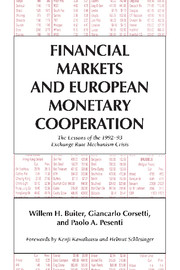 Financial Markets and European Monetary Cooperation
Financial Markets and European Monetary Cooperation Book contents
- Frontmatter
- Contents
- Forewords by Kenji Kawakatsu and Helmut Schlesinger
- Acknowledgments
- 1 Introduction
- 2 Exchange rate stability in Europe: A historical perspective
- 3 The unfolding of the 1992–93 ERM crisis
- 4 Financial markets and ERM credibility
- 5 Modelling currency crises
- 6 A Center–Periphery model
- 7 Unilateral pegs and escape clauses: The role of domestic credibility
- 8 Policy coordination and currency crises
- 9 What caused the system to crumble?
- 10 Rebuilding the system: What next?
- References
- Index
4 - Financial markets and ERM credibility
Published online by Cambridge University Press: 06 July 2010
- Frontmatter
- Contents
- Forewords by Kenji Kawakatsu and Helmut Schlesinger
- Acknowledgments
- 1 Introduction
- 2 Exchange rate stability in Europe: A historical perspective
- 3 The unfolding of the 1992–93 ERM crisis
- 4 Financial markets and ERM credibility
- 5 Modelling currency crises
- 6 A Center–Periphery model
- 7 Unilateral pegs and escape clauses: The role of domestic credibility
- 8 Policy coordination and currency crises
- 9 What caused the system to crumble?
- 10 Rebuilding the system: What next?
- References
- Index
Summary
Capital market liberalization and “convergence plays”
The goal of this chapter is to complement the narrative of the 1992–93 events by focusing on the behavior of international financial markets. The recent literature has devoted considerable efforts to analyzing determinants and dynamics of ERM credibility as perceived by market participants and reflected in movements in asset prices as well as in the composition of financial portfolios. Section 4.1 presents a few relevant stylized facts characterizing European capital flows. Section 4.2 reviews the most common measures of ERM credibility. After discussing the performance of those measures, Section 4.3 addresses to what extent financial markets were able to anticipate the 1992–93 crises.
In the policy and academic debate, the coexistence of exchange rate stability and free capital mobility in Europe has long been regarded as problematic, if not impossible. In the late 1980s, many analysts shared a deep skepticism regarding the medium-term stability of the ERM. The process of liberalization, as traced in the European Council Directives 86/566 and 88/361, was expected to increase the vulnerability of weak currency countries to rapid capital outflows, thus raising the probability of a crisis.
The emphasis on the disruptive potential of capital mobility is the straightforward corollary of the consensus view that attributed a key role to capital controls (most prominent in France and Italy) in maintaining exchange rate stability in Europe during the 1980s. The rationale for restricting capital mobility is often presented in terms of a simple application of a standard open-economy model à la Mundell-Fleming.
- Type
- Chapter
- Information
- Financial Markets and European Monetary CooperationThe Lessons of the 1992–93 Exchange Rate Mechanism Crisis, pp. 67 - 82Publisher: Cambridge University PressPrint publication year: 1998
- 1
- Cited by


